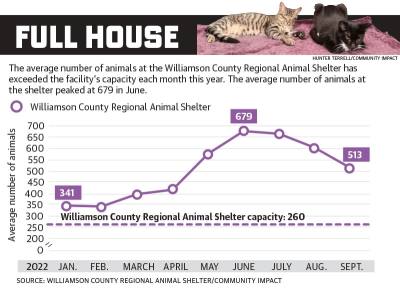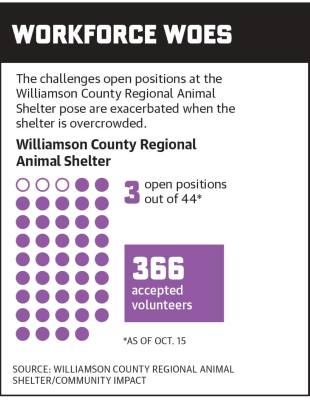April Peiffer, Williamson County Regional Animal Shelter program coordinator, said in July, the shelter reached its peak capacity for fiscal year 2021-22 with more than 674 animals in its care. The facility is designed to hold 260 maximum.
At the end of November, the shelter had 185 dogs in its care, a number that exceeds its ideal maximum dog capacity of 110 by 168.2%. Peiffer described the condition as “beyond critical.”
Central Texas SPCA, an adoption center and limited-space shelter in Leander, can take up to 25 dogs and 25 cats at a time. However, the CTSPCA is not classified as a full intake shelter, meaning it is not designed to care for as many animals as the WCRAS.
The CTSPCA receives 10-20 calls daily about strays and 10-20 about owner surrenders, shelter manager ShaiAne Belinski said.
“We have been noticing an increase in phone calls for owner surrenders or strays that have been found,” she said. “We have had a ton of strays being brought to us.”
If strays are picked up by the Cedar Park Animal Control Department or the Leander Animal Services Department and they go unclaimed, the animals are then transported to the WCRAS.
Due to overcrowding, funding shortages and understaffing, Peiffer said the shelter has been overwhelmed for months, if not years.
“I can’t remember the last time we were comfortable,” she said.
Overcapacity
The WCRAS—which serves the cities of Round Rock, Cedar Park, Hutto and Leander as well as unincorporated regions of Williamson County—was already facing hard times when the COVID-19 pandemic hit, Peiffer said.
“Being forced to close our doors [during the pandemic] to walk-ins and potential adopters and fosters impacted our staff and resources tremendously,” she said.
During that time, the organization emphasized fostering and curbside services.
“The community reacted well to our shift in services,” Peiffer said. “But the number of intakes did not slow.”
Located about 14 miles west of the WCRAS, the CTSPCA had a similarly tough time following the height of the pandemic.
“Something that I think probably a lot of shelters are dealing with right now is I guess what some would refer to as “post-COVID syndrome,” she said. “Basically ... the dogs and cats who were adopted during [the pandemic] are now being returned.”
People did and still are experiencing financial hardships and employment issues, causing them to unexpectedly surrender their pets because they can no longer care for them, Peiffer said.
Gary Bickford, Cedar Park Animal Control supervisor, said the department aims to reunite pets with their owners. If the animal control department is not able to get the strays back to their respective owners, the animals are sent to the WCRAS after a 24-hour period.
As of Nov. 15, the animal control department has impounded over 200 dogs and cats and has reunited at least 76 of those animals with their owners.
“We try to do everything we can to mitigate taking animals to the shelter,” he said.
Aside from accepting surrenders and strays, the WCRAS also works closely with animal control departments in taking on animals from cruelty cases.
In August, the WCRAS had to take in 44 animals from a cruelty case in which the facility already had more than 400 animals in its care.
“Circumstances like that push us to our limit,” Peiffer said.
She said the summation of animals from cruelty cases and from everyday surrenders has taken a toll on their resources and staff.
When strays are brought to the CTSPCA, they can scan them for microchips, but they cannot kennel the animals. Because the CTSPCA is not a full intake shelter, it has to route animals brought to it to the other local or county shelters.
Belinski said the CTSPCA does, however, try to take in animals when space allows to relieve the burden on the WCRAS. This has happened about four times in the last two or three months, Belinski said.
“I wish that we could help, ... but unfortunately our policies don’t allow us to do that,” she said. “We do our best by trying to pull from [the WCRAS] as much as we can though.”
Ongoing challenges
Peiffer said funding levels for the animal shelters are not enough to support staff and operational needs.
“We are grateful for the money that we receive from our community leadership,” she said. “But when we are overwhelmed by animal intake, funds can diminish quicker than expected.”
In FY 2021-22, the WCRAS received a total of $2.6 million from its serviced jurisdictions with $1.49 million of that from Williamson County, $547,223 from Round Rock, $255,266 from Cedar Park, $187,911 from Leander and $144,930 from Hutto.
The WCRAS has also received annual support from national nonprofit Petco Love.
“The Williamson County Animal Shelter is one of the most effective and productive organizations in the region,” Petco Love President Susanne Kogut said. “We are proud to have invested over $1 million to support [Williamson County] and their work.”
Additionally, the WCRAS received $684,731 from community donations and grants in 2021-22, an annual report showed.
The CTSPCA relies solely on donations and fundraising efforts.
“[The CTSPCA isn’t] city or state funded,” Belinski said. “Our funds strictly come from things like adoption fees, donations [and] fundraising.”
Another challenge facing the local shelters is staffing.
As of Nov. 14, CTSPCA had one vacant position, and the WCRAS had three vacant positions out of 44.
Peiffer said while these numbers may seem small, they are significant when caring for double or even triple the amount of animals the facility is designed for.
Belinski and Peiffer said even if all their positions were filled, they would still need volunteers.
“I am thankful for all the employees and volunteers who give their time and effort at the Williamson County Regional Animal Shelter,” Williamson County Precinct 3 Commissioner Valerie Covey said. “We could never operate a successful shelter without them.”
Future partnership
With the county quickly growing, Peiffer said the region will more than likely have to serve more animals.
“We are keeping a close eye on the growing number of animals the shelter continues to see and the possible need for expansion in the future,” Williamson County Judge Bill Gravell said.
The WCRAS is also hosting its annual Home For The Holidays fostering program—a program that allows any medium to large adult dog to be a foster pet throughout the holiday season.
Fostering is an effort to help the shelters by freeing up space for new animals. Foster parents can also opt to adopt their foster pet if things go well, and if not, the dog can be returned after the holidays. The program began Nov. 18 and will run through Jan. 2.
The CTSPCA will also continue working to keep animals out of local shelters through its adoption and fostering programs, Belinksi said.
“The more dogs that we can adopt out to forever families, the more dogs we can pull from other shelters who really need the help,” she said. “We will always do whatever we can to help the other shelters in the area, especially [the WCRAS], who we have such a wonderful relationship with, ... anything to help them get to a normal operating capacity.”









